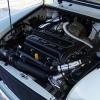It sounds like you might be "flooding the engine", (filling the cylinders with an excessively rich air-fuel mixture that cannot be ignited because the mixture exceeds the upper explosive limit of the petrol, sometimes even fouling the spark plugs.) Basically too much petrol is going into the cylinders to the point that it becomes too wet to ignite. This used to be a very common problem when all cars had carbs, but it's pretty much unheard of in modern cars since the introduction of fuel injection. The reason the car starts after half an hour or so, is because some of the petrol will have evaporated in that time allowing it to ignite again and for the engine to restart. Every time you try and restart it before this time, you make the problem worse by pumping yet more fuel into the cylinders as you crank the engine over in an attempt to re-start it.
Many things can cause and contribute to flooding, although it's most commonly caused by drivers who pump the accelerator pedal when trying to start the car. Other contributing factors include an or over rich fuel mixture, poorly adjusted/stuck choke, poor spark and the timing being out.
On an SU HS OR HIF carburetor pushing the accelerator on start up will not alter the mixture on start up enough to create a flooding situation, this usually only applies to carbs that have that feature built in. I would say if the mixture was too rich to flood the engine in this manner the OP would not have to use the choke to start his car in the morning.
Accelerator pump Liquid gasoline, being denser than air, is slower than air to
react to a force applied to it. When the throttle is rapidly opened, airflow through the carburetor increases immediately, faster than the fuel flow rate can increase. This transient oversupply of air causes a lean mixture, which makes the engine misfire (or "stumble")—an effect opposite what was demanded by opening the throttle. This is remedied by the use of a small
piston or
diaphragm pump which, when actuated by the throttle linkage, forces a small amount of gasoline through a jet into the carburetor throat.
[4] This extra shot of fuel counteracts the transient lean condition on throttle tip-in. Most accelerator pumps are adjustable for volume and/or duration by some means. Eventually the seals around the moving parts of the pump wear such that pump output is reduced; this reduction of the accelerator pump shot causes stumbling under acceleration until the seals on the pump are renewed.
The accelerator pump is also used to prime the engine with fuel prior to a cold start. Excessive priming, like an improperly adjusted choke, can cause flooding. This is when too much fuel and not enough air are present to support combustion. For this reason, most carburetors are equipped with an unloader mechanism: The accelerator is held at wide open throttle while the engine is cranked, the unloader holds the choke open and admits extra air, and eventually the excess fuel is cleared out and the engine starts. Source: Wikipedia,
Edited by liirge, 02 December 2011 - 11:13 AM.
















